
![]()
ss Kermia - Curaçao
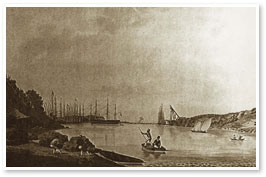
The Amerindian Arawaks were the first inhabitants of Curaçao, before the Spanish lieutenant Alonso de Ojeda visited the island in 1499.
In 1634, long after the Spanish had abandoned Curaçao, the Dutch West Indies Company or
VOC claimed the island. In 1642, Peter Stuyvesant was installed as governor. Curaçao soon became a Dutch commercial center and developed extensive slave trade activities. During this period, the local language Papiamentu—a mixture of Portuguese, Spanish, Dutch, and African dialects, developed by the slaves—became the main means of communication. Peter Stuyvesant left Curaçao in 1647 to become Governor of New Amsterdam, later to become New York City. It is interesting to note that the Dutch language now has been replaced by the Papiamentu language as the official island's language.The island of Curaçao is the biggest of the three islands of the Netherlands Dutch Antilles or Dutch West Indies and in the days that arrived for the first time it was flourishing due to the big Shell refinery. It created a lot of employment for the locals and also for the Dutch Shell expats who were present in rather big numbers. Surfing on top of the Cat Cracker wave. With the discovery of oil in 1914, at Lake Maracaibo in Venezuela, the Caribbean Petroleum Company decided to build a refinery on Curaçao. It became operative in May 1918. The 440 ha. refinery at Schottegat was later acquired in the 1960s in hands by Shell Curaçao N.V. and at one time employed 25,000 people from all over the world. The island itself only measures about 40 square kilometers and is what Homerus would call 'good goat country'. Meaning that almost no vegetation is present apart from cactuses, barely enough to support the tough goats.
When I arrived on the island for the first time in 1957 I was amazed at the level of prosperity which was far beyond the meagre situation back home. Holland was then just climbing out of the pit caused by World war II and everybody was living in rather poor and Spartan circumstances even then. I was amazed by the large number of big American car also convertibles driving around in all kinds of sweet colours and owned and driven by the local people. There was no shortage of anything on the island although all foods and equipment had to be imported mainly from the United States. Nearing the island we could already receive the local radio station which was broadcasting to my surprise commercial messages. In the mean time I had become used to the American commercials by now, but hearing those in the Dutch language was rather special. The nice thing was the amateurish style of the commercials. The same voice which we heard announcing the records played - yes records - and read the news was also reading the live commercials. I remember the one of Spritzer and Fuhrman, the local jeweller. The entire island was drenched with Shell so to speak and the economy was almost solely based on the one refinery, tourism being second at a large distance. The island's economy was standing on one leg like the island itself. Curaçao in a geological sense is shaped like a mushroom, standing on a stem, while the mushroom's cap protrudes out of the sea. Locals in general were rather unfriendly and the expats usually arrogant and at a distance to simple sailors like ourselves. They were of a higher class or caste it sometimes seemed. Probably because of that some of my colleague officers, who had been in Curaçao already many times, did not think much of the island and suggested that mushroom's cap should be separated from the stem by means of a big spade so that the island would drift away, forever as far as they cared. For me as a newbie it was all very nice and exciting. To arrive in a place far away from home were they speak you tongue is kind of special anyway.

Schottegat is the harbour of Willemstad which is the main city on the island. The pictures show an aerial view of the Abida, a modernized version of the K-tankers, lying at the Shell terminal in the Schottegat bay.The photo with courtesy to my colleague Jan Dissel of the Abida, who took it during a flight with a Pipercup over the island.The oil film on the water was ever present and not caused by the refinery. Natural oils seemed to ooze out of the harbour bassin' floot. Well, that I was told.
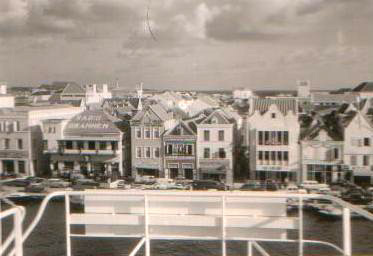 |
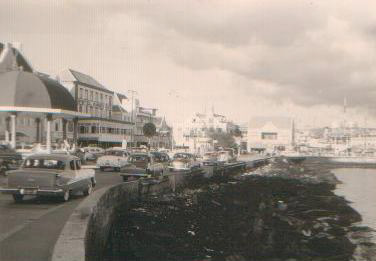 |
|
| A view of Willemstad from the Kermia's top deck when we were leaving again. | The picture shows state of the art (1957) cars which were driving around in big numbers. |
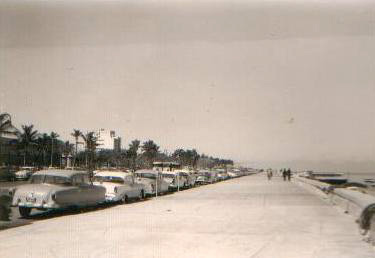 |
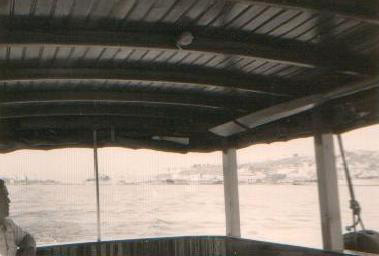 |
|
| A boulevard but I do not recognize this now. | Shell's ferry boat from the refinery to town and v.v. |
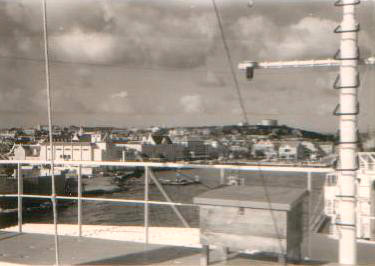 |
|
| Sailing through the Schottegat. | The hotel at the harbour's entrance in those days. |
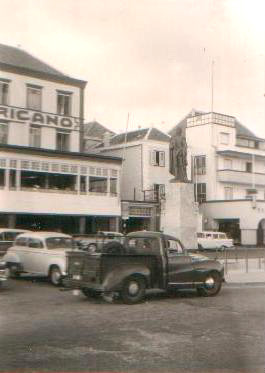
There is a statue in the picture. Whose is it?
In the early days of cruise tourism Curaçao quickly earned the reputation of being one of the best ports of call in the Caribbean and a shopper's paradise. Cruise tourism was and still is important to the island which offers many shops, mostly concentrated in the downtown area of Willemstad, in the districts Punda and Otrobanda. Punda is the city’s commercial center, with several shops offering a variety of shopping items like clothing, footwear, cosmetics, jewelry, perfumes, electronics and souvenirs. The Heerenstraat and Madurostraat are pedestrian areas. Otrobanda’s main shopping street is the Breedestraat. There are also some small shopping centers scattered over the island, some even open on Sunday mornings. A famous name on the island is Spritzer & Fuhrman than the most important jeweller and watch selling store on the island and even had a showroom on 57th Street in New York. Look local and buy abroad. This is beginning to sound as a commercial..... Once I was trying to buy a watch at Spritzer & Fuhrman' shop when an American tourist invasion took place at that moment. The sales girl who had being helping me sofar became very nervous and more or less ordered me out. Please come back some other time. Makamba's as the white people were called were not welcome at such moments. What can one do about it? Nothing, but to stay away forever which I did.
Personally I have good memories of the island as the atmosphere was agreeable and the climate nice. A little bit hot but the passat wind was always blowing, same strength same direction, trees growing askew and all pointing into the same direction. As staff members of a Shell vessel we had free entry to things like Piscadera Bay which was a nice sea side resort with bars, gardens and above all a private beach. We also sometimes went sailing on Spanish Waters as I think the name was. Shell's own marina was located there and also this was free of charge. As was Shell's ferryboat who brought us to and from Willemstad. If you did not feel like taking the ferry you dialed a service number and some time later a black limousine pulled up near the gangway. You could name any place to go to. No costs. I attended theatre performance of Dutch artists, which of course were free of charge. Shell had its own city on the island and were very good for the Shell employees. Housing for the expats was well taken care of. If the refrigerator failed an employee dialed a service number and within short a car with two locals pulled and exchanged the refrigerator. It seemed that nothing was repaired but thrown away. Also if a lightbulb in the house exceeded its lifespan the service number was called and two guys came to fix the problem. There was a very well equipped Shell hospital and polyclinic. That and medication was free for everybody. Easy living I would say. The trees were growing into heaven as we say in Holland. The only problem for us was that the Antillian Guilder was worth 2 Dutch Guilders, there halving our expense money. But then with so much free of charge you did not need much to get by on the island.
Just outside the gate was a Shell recreational facility with a bar, billiard table and a small store. Here we used to buy the famous Alcolado Glacial, a local product also known as 'ice water'. For us it was a kind of substitute for air conditioning.

Alcolado Glacial in commericals also called: The Air-conditioner in a bottle.
In the tropics we used to rub an amount of the liquid on the chest just before sleeping. With the cabin's ventilators focussed on the same body area one drifted away very soon. It felt very cool indeed on the skin. A the bar the favourite drink in those was Cuba Libre, rum and coke. The only thing that could spoil the atmosphere was the entrance of a Norwegian ship's crew who had just arrived. Norwegian ships were 'dry' meaning that no alcohol in any form was available. Within half an hour after entering the first Norwegians used to fell of the bar stools. Their intake capacity was enormous but as they were not used to liquor for a while the effect tripled. So far so good, but now they began to fight amongst themselves and then with just anybody at hand. So we parted their company just before the hostilities began. The end of the fun was that the Shell's police, all burly black islanders, would step in and kick some white ass just for the hell of it. By the look of it they rather enjoyed it. Also the neat butterflyed bartenders joined the party with swinging billiards cues.